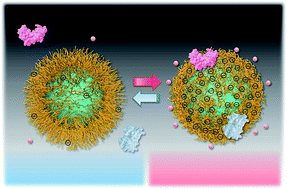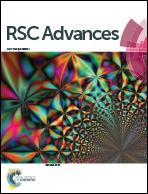Thermoresponsive anionic block copolymer brushes with a strongly anionic bottom segment for effective interactions with biomolecules†
Abstract
Brushes were prepared from a thermoresponsive strongly anionic block copolymer, namely poly(2-acrylamido-2-methylpropanesulfonic acid) (AMPS)-b-poly(N-isopropylacrylamide) (PAMPS-b-PIPAAm), by multistep atom-transfer radical polymerization with pH control of the reaction solution. The prepared block copolymer brushes were characterized using CHN elemental analysis, X-ray photoelectron spectroscopy, contact angle measurements, and zeta potential measurements. The results showed that dense polymer brushes were formed on the silica surfaces, and showed thermally modulated changes in their hydrophobic and anionic properties. Chromatographic analyses using silica beads modified with PAMPS-b-PIPAAm brushes as column-packing materials showed that the block copolymer brushes interacted more strongly with basic biomolecules than did brushes of a random copolymer, namely P(IPAAm-co-AMPS). PAMPS-b-PIPAAm copolymer brushes could therefore provide effective thermoresponsive anionic interfaces with strong anionic properties that could be modulated by changing the external temperature.


 Please wait while we load your content...
Please wait while we load your content...